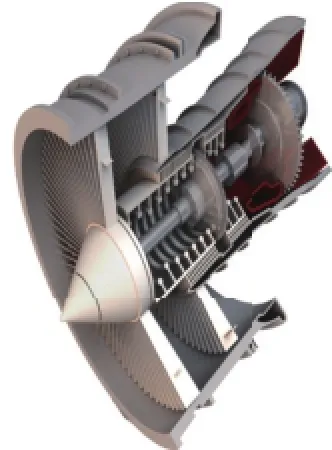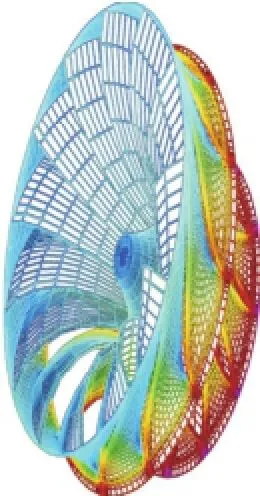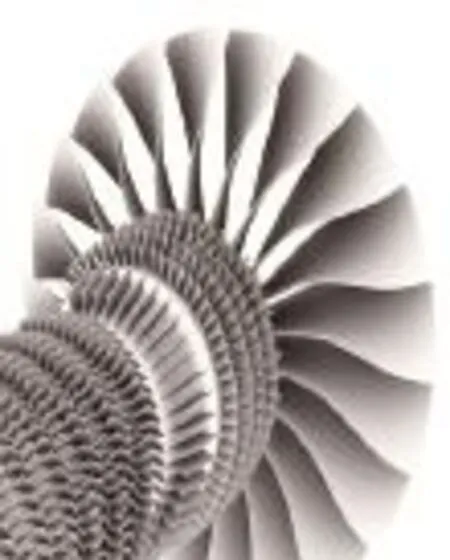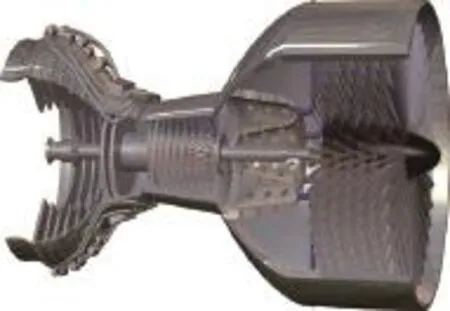ENGINES, THE HEART OF AIRCRAFT
2016-04-17TextbyMadelineTranslationbyLeoPhotosbyGaoping
Text by Madeline Translation by Leo Photos by Gaoping
ENGINES, THE HEART OF AIRCRAFT
Text by Madeline Translation by Leo Photos by Gaoping
The engine is not only a major source of propulsion, but is also a source of electric power, gas, drinking water, hydraulic pressure and air pressurisation for an aircraft. Its reliability is crucial to flight safety.


Turbofan engine涡轮风扇发动机剖面图

(CAD screen display of pressures on a turbine wheel) The wheel also compresses the air, which is then mixed with fuel and ignited to provide power.涡轮机叶轮压力CAD示意图:叶轮将空气压缩后,空气与燃油混合后被点燃发生爆炸,以此提供发动机动力。
The aero engine is a highly complex,precise, thermalmechanical system that provides the thrust required by an aircraft to take off, cruise and land. No aircraft can leave the ground without an engine.
High Technical Barriers to Entry
An aircraft engine has a direct effect on the aircraft's performance, reliability and economics. It reflects a nation's strength in science and technology, industry and national defence in an important way. Technically, the barrier to entry is very high. High requirements for materials, sophisticated parts and precise automatic controlsall play a part. For example, the blades of a turbine engine must withstand temperatures of more than 1,000 degrees Celsius.
Thrust
The engine works to provide suficient forward thrust so that aircraft can take off if other conditions such as aerodynamics and shape are met. It can also generate reverse thrust by changing the direction of exhaust flow to slow down the aircraft after landing.
A typical aero engine provides thrust in the range of 22,000 to 33,000 pounds (or about 10-15 tons). This is equivalent to all air in a room of dozens of square metres sucked up within one second. The maximum forward thrust that an existing aircraft engine can provide is more than 50 tons.
Engine Types
Engine types that are still in use today include piston, turbojet, turboprop, turboshaft, turbofan and propfan engines, which cover major milestones in the history of aero engines over thecourse of more than 100 years, including civilian or military use, or use in the aerospace industry. The turbofan, being the latest, embodies many great improvements in thrust, efficiency and energysaving and environmental performance.
发动机:飞机的心脏
没有发动机,飞机就不能起飞。它不仅是飞机的主要动力来源,还为飞机提供电源,气源以及饮用水、液压、空调的增压。


The wheel is comprised of blades which spin and draw in air.叶轮由多个叶片组成,叶片通过旋转吸入空气。
The engine powering most civil passenger aircraft
The vast majority of jet-propelled airplanes today are powered by turbofan engines, thanks to their excellent performance when the airplanes cruise at a speed between 400-1000 km/h. The turbofan engines produce power by sucking in air at the front and blasting out hot exhaust gases at the back. Temperatures of the exhaust gases may reach as high as 500-600 degrees Celsius.
Thanks to their large diameter fans, the turbofan engines have two major merits - extremely powerful thrust and very low fuel consumption, which are crucial requirements for any civil aircraft to make economic and environmental sense. However, the same feature is also a weakness - the turbofan engines produce too much drag. This, combined with their relatively poor speed characteristics, will lead to a marked drop in thrust when the aircraft fly at high speeds. Therefore, the turbofan engines only suit subsonic flight.
To take off and fly higher in the sky, aircraft need enough lift, which is up to the thrust generated by the engines. The bigger an aircraft is, the greater lift and more engines to provide thrust it requires. For example, the “Jumbo Jet” Boeing 747 needs four engines to provide thrust, while the Airbus A320 only requires two. Some aircraft for military use have up to 6-8 engines.
